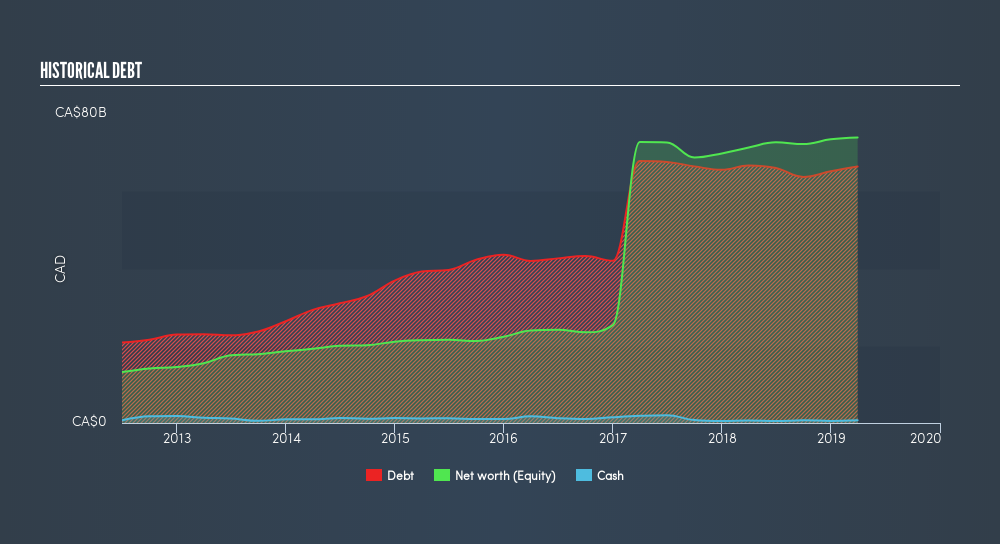
Want to participate in a short research study? Help shape the future of investing tools and you could win a $250 gift card!
The external fund manager backed by Berkshire Hathaway's Charlie Munger, Li Lu, makes no bones about it when he says 'The biggest investment risk is not the volatility of prices, but whether you will suffer a permanent loss of capital.' So it might be obvious that you need to consider debt, when you think about how risky any given stock is, because too much debt can sink a company. We note that Enbridge Inc. (TSE:ENB) does have debt on its balance sheet. But should shareholders be worried about its use of debt?
When Is Debt A Problem?
Debt is a tool to help businesses grow, but if a business is incapable of paying off its lenders, then it exists at their mercy. Ultimately, if the company can't fulfill its legal obligations to repay debt, shareholders could walk away with nothing. However, a more frequent (but still costly) occurrence is where a company must issue shares at bargain-basement prices, permanently diluting shareholders, just to sure up its balance sheet. By replacing dilution, though, debt can be an extremely good tool for businesses that need capital to invest in growth at high rates of return. The first step when considering a company's debt levels is to consider its cash and debt together.
Check out our latest analysis for Enbridge
What Is Enbridge's Debt?
As you can see below, Enbridge had CA$66.4b of debt, at March 2019, which is about the same the year before. You can click the chart for greater detail. Net debt is about the same, since the it doesn't have much cash.

How Strong Is Enbridge's Balance Sheet?
The latest balance sheet data shows that Enbridge had liabilities of CA$13.1b due within a year, and liabilities of CA$79.5b falling due after that. Offsetting this, it had CA$709.0m in cash and CA$6.38b in receivables that were due within 12 months. So it has liabilities totalling CA$85.5b more than its cash and near-term receivables, combined.
This is a mountain of leverage even relative to its gargantuan market capitalization of CA$95.7b. This suggests shareholders would heavily diluted if the company needed to sure up its balance sheet in a hurry. Either way, since Enbridge does have more debt than cash, it's worth keeping an eye on its balance sheet.
We use two main ratios to inform us about debt levels relative to earnings. The first is net debt divided by earnings before interest, tax, depreciation, and amortization (EBITDA), while the second is how many times its earnings before interest and tax (EBIT) covers its interest expense (or its interest cover, for short). The advantage of this approach is that we take into account both the absolute quantum of debt (with net debt to EBITDA) and the actual interest expenses associated with that debt (with its interest cover ratio).
With a net debt to EBITDA ratio of 6.02, it's fair to say Enbridge does have a significant amount of debt. However, its interest coverage of 2.80 is reasonably strong, which is a good sign. Fortunately, Enbridge grew its EBIT by 9.2% in the last year, slowly shrinking its debt relative to earnings. When analysing debt levels, the balance sheet is the obvious place to start. But ultimately the future profitability of the business will decide if Enbridge can strengthen its balance sheet over time. So if you're focused on the future you can check out this free report showing analyst profit forecasts.
Finally, a business needs free cash flow to pay off debt; accounting profits just don't cut it. So the logical step is to look at the proportion of that EBIT that is matched by actual free cash flow. In the last three years, Enbridge created free cash flow amounting to 5.7% of its EBIT, an uninspiring performance. For us, cash conversion that low sparks some a little paranoia about is ability to extinguish debt.
Our View
We'd go so far as to say Enbridge's net debt to EBITDA was disappointing. But on the bright side, its EBIT growth rate is a good sign, and makes us more optimistic. Overall, it seems to us that Enbridge's debt load is really quite a risk to the business. For this reason we're pretty cautious about the stock, and we think shareholders should keep a close eye on the balance sheet . Given our hesitation about the stock, it would be good to know if Enbridge insiders have sold any shares recently. You click here to find out if insiders have sold recently.
When all is said and done, sometimes its easier to focus on companies that don't even need debt. Readers can access a list of growth stocks with zero net debt 100% free, right now.
We aim to bring you long-term focused research analysis driven by fundamental data. Note that our analysis may not factor in the latest price-sensitive company announcements or qualitative material.
If you spot an error that warrants correction, please contact the editor at editorial-team@simplywallst.com. This article by Simply Wall St is general in nature. It does not constitute a recommendation to buy or sell any stock, and does not take account of your objectives, or your financial situation. Simply Wall St has no position in the stocks mentioned. Thank you for reading.
About TSX:ENB
Average dividend payer with acceptable track record.
Similar Companies
Market Insights
Community Narratives



